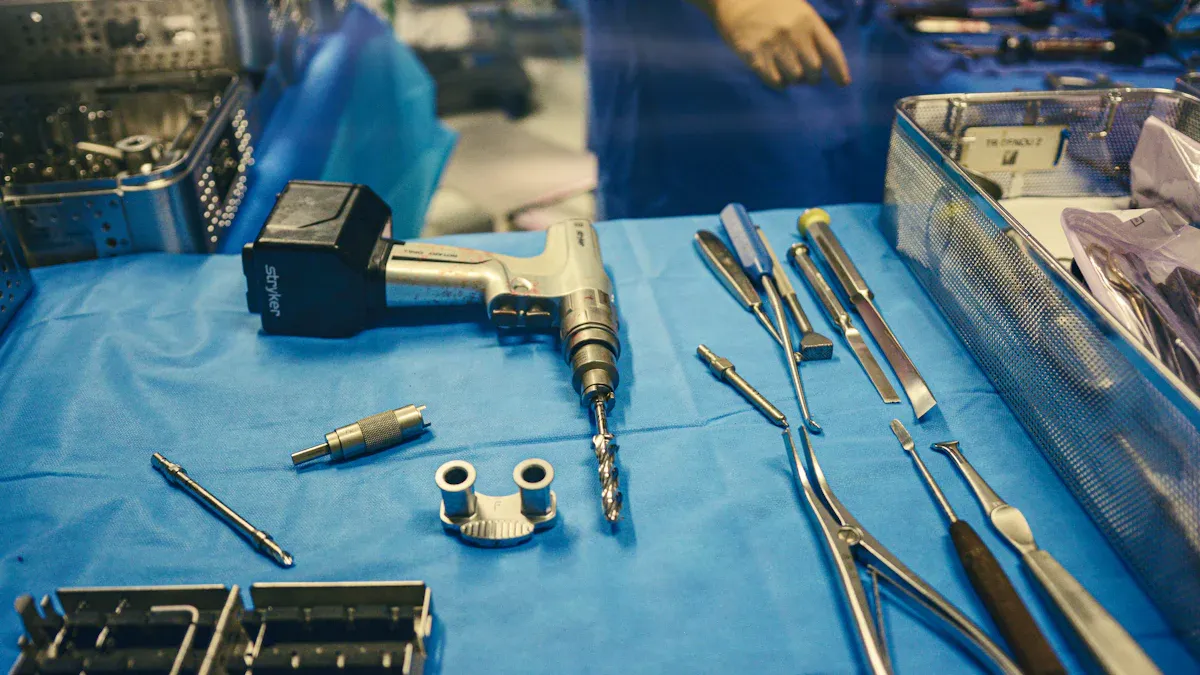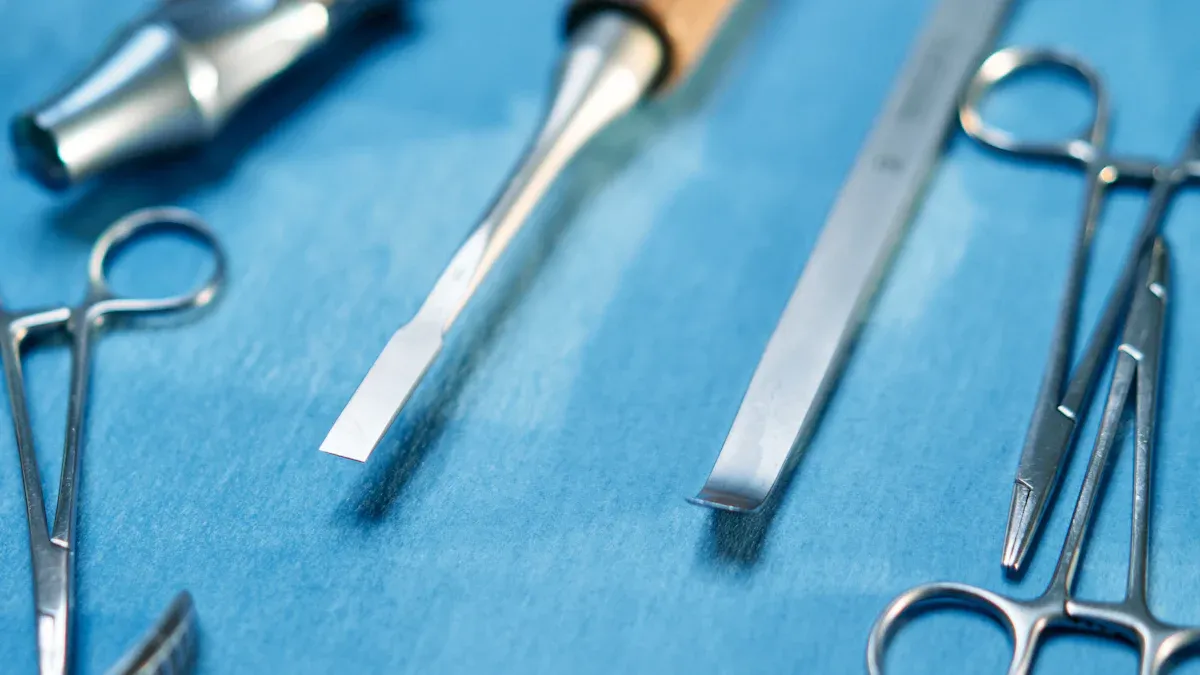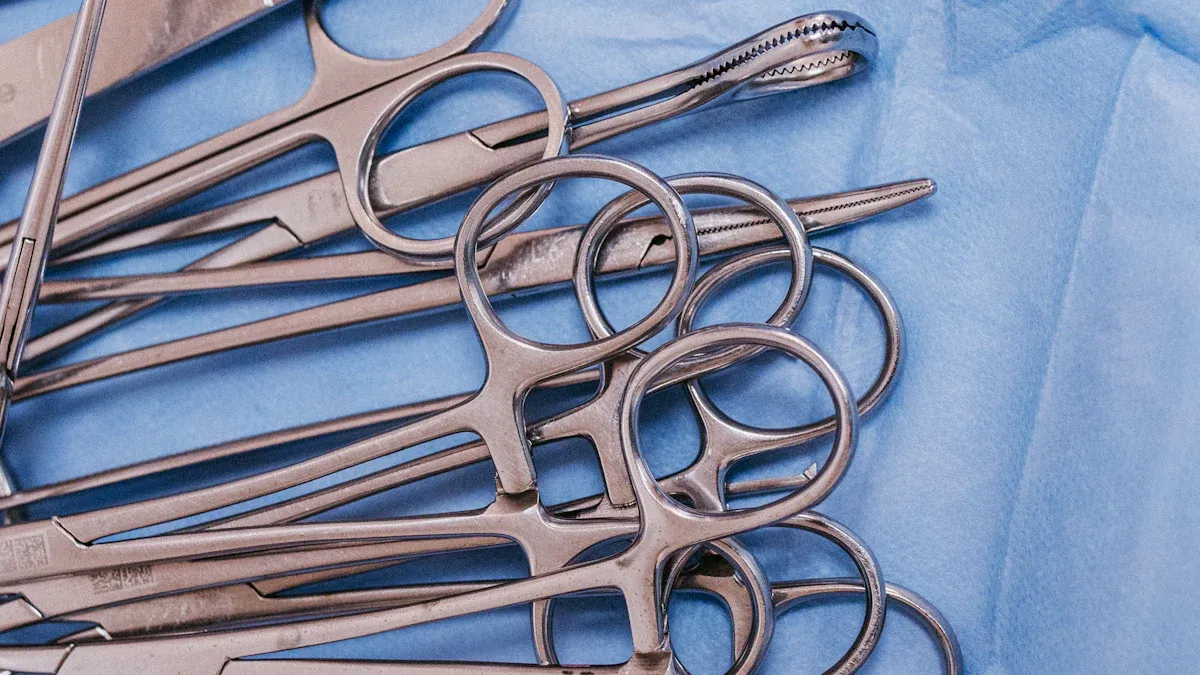How Nitinol Tubing is Transforming Surgical Instruments

Imagine a material that can remember its shape, bend without breaking, and work seamlessly with the human body. Nitinol tubing for minimally invasive surgical instruments does exactly that. Its unique properties allow you to benefit from advanced surgical tools that are both flexible and durable. This innovation has made surgeries less invasive, reducing recovery times and improving patient outcomes. With its biocompatibility and resistance to corrosion, Nitinol tubing has become a game-changer in modern medicine.
Key Takeaways
Nitinol tubing can change shape and bend easily. This helps tools fit the body better and work more precisely.
Nitinol is safe for the body, lowering the chance of bad reactions. This makes surgeries safer for patients.
Its bendable nature allows smaller cuts, causing less harm to tissues. Patients feel less pain and heal faster.
Nitinol lasts long and doesn’t rust, making it reliable. It’s also a smart and affordable choice for medical tools.
New Nitinol technology may create custom medical tools. This improves treatments and makes patients more comfortable.
Unique Properties of Nitinol Tubing for Minimally Invasive Surgical Instruments

Shape Memory and Superelasticity
Nitinol tubing for minimally invasive surgical instruments stands out due to its remarkable shape memory and superelasticity. These properties allow the material to return to its original shape after deformation, making it ideal for devices that need to adapt to complex anatomical structures. For example, stents and guidewires benefit from this ability, ensuring they perform reliably even under challenging conditions.
The reliability of Nitinol deformation simulations depends on experimental data. This data helps calibrate models that predict how Nitinol behaves under various stresses. Tensile testing reveals its elasticity, superelasticity, and plasticity, ensuring that medical devices made from Nitinol tubing meet the highest standards of performance.
Nitinol exhibits a shape memory effect, enabling precise device functionality.
Its superelasticity allows it to endure significant strain without permanent deformation.
These features make it indispensable in surgical tools like catheters and stents.
Biocompatibility and Corrosion Resistance
When you use surgical instruments made from Nitinol tubing, you benefit from its exceptional biocompatibility. This means the material works harmoniously with the human body, reducing the risk of adverse reactions. Additionally, Nitinol resists corrosion, even in the presence of bodily fluids, ensuring long-term reliability.
Medical devices like stents and orthopedic implants rely on these properties to maintain their integrity during prolonged use. Nitinol tubing’s ability to withstand harsh environments makes it a preferred choice for minimally invasive surgical instruments. Its biocompatibility ensures patient safety, while its corrosion resistance guarantees durability.
Flexibility and Durability
The flexibility and durability of Nitinol tubing for minimally invasive surgical instruments enhance their reliability during procedures. Its superelasticity allows devices to navigate tight spaces and complex pathways without losing stability. This is crucial for precision in delicate interventions, such as cardiovascular surgeries.
Evidence Description | Key Contribution to Reliability |
|---|---|
Nitinol's durability and precision are critical for the success of minimally invasive procedures. | Exceptional resistance to fatigue ensures structural integrity under repeated use, vital for guidewires and catheters. |
Nitinol enhances the precision and flexibility of medical devices. | Superelasticity and shape memory properties allow navigation through complex pathways, reducing procedural errors. |
Exceptional flexibility improves device performance. | Allows bending through tight spaces while maintaining stability, crucial for precision in delicate interventions. |
This combination of flexibility and durability ensures that Nitinol tubing remains a cornerstone of innovation in surgical instruments. It allows you to achieve better outcomes with fewer complications, making it an invaluable material in modern medicine.
Applications of Nitinol Tubing in Minimally Invasive Procedures

Stents and Cardiovascular Devices
Nitinol has revolutionized the design and functionality of stents used in minimally invasive procedures. These devices rely on nitinol's shape memory and superelasticity to adapt to the dynamic environment of blood vessels. When you use stents made from nitinol, they expand precisely to fit the vessel, ensuring optimal blood flow. Their flexibility allows them to navigate through narrow or curved arteries without compromising performance.
The corrosion resistance of nitinol ensures that stents remain durable even in the challenging conditions of the cardiovascular system. This reliability reduces the risk of complications, making nitinol stents a preferred choice for treating conditions like arterial blockages and aneurysms. By incorporating nitinol tubing, stents have become more effective and safer for patients undergoing minimally invasive procedures.
Catheters and Guidewires
Catheters and guidewires are essential tools in minimally invasive procedures, and nitinol tubing has significantly enhanced their performance. Nitinol's flexibility allows catheters to navigate complex anatomical pathways with ease, while its durability ensures they maintain their structural integrity during use. Guidewires made from nitinol exhibit exceptional superelasticity, enabling them to bend and flex without breaking.
The Silverway guidewire achieved a vessel crossing success rate of 98% in patients.
Catheters were successfully delivered in 92% of cases.
No clinically relevant complications were reported after the use of the guidewire.
These statistics highlight the reliability and safety of nitinol-based catheters and guidewires. When you use these devices, you benefit from their precision and adaptability, which are critical for successful outcomes in minimally invasive procedures.
Orthopedic Implants and Surgical Tools
Nitinol tubing has also transformed orthopedic implants and surgical tools. Its unique properties allow implants to move with the body, reducing stress on bones and tissues. This promotes faster healing and improves patient comfort. For example, spinal implants made from nitinol maintain their shape and fit perfectly, ensuring long-term reliability.
Evidence Description | Key Benefits |
|---|---|
Nitinol tubing enhances orthopedic implants by allowing them to move with the body. | Reduces stress on bones and tissues, promoting faster healing. |
Nitinol is biocompatible and does not rust. | Ensures safety and reliability for long-term use in implants. |
Fixation devices made from nitinol are strong yet flexible. | Provides stable support for broken bones during recovery. |
Nitinol's shape memory allows devices to adjust to body movements. | Lowers risks of complications and improves overall effectiveness of fixation devices. |
The flexibility of nitinol enhances comfort and fit in spinal devices. | Ensures that spinal implants maintain their shape and fit perfectly, improving patient comfort. |
When you choose surgical tools and implants made from nitinol, you gain the benefits of a material that combines strength, flexibility, and biocompatibility. These advantages make nitinol tubing an indispensable component in modern orthopedic applications.
Robotic-Assisted Surgical Technologies
Robotic-assisted surgical technologies have transformed the way you experience medical procedures. These systems combine precision, flexibility, and advanced materials to perform complex surgeries with minimal invasiveness. Nitinol plays a critical role in this innovation, particularly in the development of concentric tube robots. These robots use nested groups of pre-curved elastic tubes made from nitinol. This design allows the tubes to bend and deform through structural interaction, enabling precise movements in confined spaces.
The unique properties of nitinol, such as shape memory and superelasticity, make it ideal for robotic-assisted systems. These properties allow surgical robots to maintain their shape and stiffness while navigating intricate anatomical pathways. For example, nitinol tubing enhances the performance of robotic arms by providing higher stiffness and flexibility. This combination ensures that the robot can apply the necessary manipulation forces without compromising accuracy.
You benefit from these advancements in several ways. Robotic-assisted technologies equipped with nitinol tubing improve surgical precision, reducing the risk of errors. They also enable smaller incisions, which means less scarring and faster recovery times. Additionally, the biocompatibility of nitinol ensures that the materials used in these systems are safe for your body.
The integration of nitinol tubing into robotic-assisted surgical technologies represents a significant leap forward in healthcare. By addressing limitations in traditional surgical tools, these innovations provide surgeons with enhanced capabilities. As a result, you can expect better outcomes and a more comfortable recovery process. Nitinol continues to push the boundaries of what is possible in modern medicine, making robotic-assisted surgeries more effective and accessible.
Advantages of Nitinol Tubing in Medical Devices
Precision and Adaptability in Surgical Instruments
Nitinol tubing enhances the precision and adaptability of surgical instruments, making them indispensable in modern procedures. Its shape memory properties allow instruments to return to their original form after deformation. This ensures that tools maintain their accuracy during surgeries, even in challenging conditions. Superelasticity further improves performance by enabling instruments to bend and twist repeatedly without losing functionality.
You benefit from these features during complex procedures, where precise control is crucial. For example, nitinol's enhanced maneuverability allows surgeons to navigate intricate anatomical structures with ease. This results in better surgical outcomes and minimizes the risk of complications.
Instruments made from nitinol maintain their structural integrity under stress.
Enhanced control improves the ability to perform delicate interventions.
These properties make nitinol tubing a cornerstone of precision in medical devices.
Enabling Smaller Incisions and Faster Recovery
Nitinol tubing plays a vital role in enabling smaller incisions during surgeries. Its flexibility allows medical devices to navigate complex pathways with minimal tissue disruption. This reduces trauma and leads to faster recovery times for patients. Smaller incisions also mean less scarring and a lower risk of post-operative complications.
When you undergo a procedure using nitinol-based instruments, you experience the benefits of advanced technology designed for minimal invasiveness. Superelasticity ensures that devices can bend and adapt to your anatomy without losing their effectiveness. This combination of flexibility and durability makes nitinol tubing ideal for procedures requiring precision and care.
Tip: Smaller incisions not only improve recovery times but also enhance patient comfort by reducing pain and scarring.
Improved Patient Comfort and Outcomes
Nitinol tubing significantly improves patient comfort and outcomes by combining biocompatibility, flexibility, and durability. Its biocompatibility minimizes the risk of inflammation or rejection, ensuring that medical devices work harmoniously with your body. The material's flexibility allows for smoother navigation through your anatomy, reducing tissue damage and discomfort.
Durability is another key advantage. Nitinol tubing resists fatigue and maintains its structural integrity over time, making it ideal for long-term use in implants and surgical tools. These features contribute to safer procedures and better overall results.
Nitinol minimizes inflammation risks, enhancing patient safety.
Its durability ensures reliable performance in long-term applications.
Flexible devices reduce trauma, leading to faster recovery and improved comfort.
By choosing nitinol-based medical devices, you gain access to cutting-edge technology that prioritizes your well-being. This innovation continues to transform healthcare, delivering better outcomes for patients worldwide.
Cost-Effectiveness and Long-Term Reliability
When you choose medical devices made from nitinol tubing, you benefit from their exceptional cost-effectiveness and long-term reliability. These devices are designed to last, reducing the need for frequent replacements or repairs. Their durability ensures consistent performance, even under demanding conditions, making them a smart investment for healthcare providers.
The biocompatibility of nitinol tubing enhances patient safety by minimizing the risk of adverse reactions. This feature reduces complications, which can lower overall treatment costs. For example, stents and implants made from nitinol maintain their integrity over time, ensuring they perform as intended without causing harm.
Note: Long-lasting devices not only save money but also improve patient outcomes by reducing the need for repeat procedures.
Enhanced flexibility is another key advantage of nitinol tubing. This property allows devices to adapt to complex anatomical structures, ensuring precise performance during minimally invasive procedures. By enabling smaller incisions, nitinol-based devices contribute to reduced recovery time and faster healing. This means fewer hospital stays and lower medical expenses for you.
Feature | Benefit |
|---|---|
Durability | Reduces the need for replacements, saving costs. |
Biocompatibility | Enhances safety and minimizes complications. |
Enhanced flexibility | Improves device performance and reduces recovery time. |
Long-term reliability | Ensures consistent results, lowering the risk of additional surgeries. |
When you consider the long-term benefits, nitinol tubing stands out as a cost-effective solution. Its combination of safety, durability, and adaptability ensures that you receive high-quality care while minimizing expenses. This innovation continues to transform healthcare by delivering reliable and affordable solutions for patients and providers alike.
The Future of Nitinol Tubing in Healthcare
Innovations in Material Science and Manufacturing
Advancements in material science are unlocking new possibilities for nitinol in healthcare. Researchers are improving the properties of nitinol alloys, such as enhancing thermal stability and fine-tuning shape memory temperatures. These innovations allow nitinol to adapt to various environmental conditions, making it even more versatile for medical applications. For example, orthodontic wires and vascular filters now benefit from nitinol's ability to maintain shape memory at body temperature.
Manufacturing techniques are also evolving. New methods enable the production of nitinol tubing with greater precision and consistency. This ensures that advanced surgical instruments meet the highest performance standards. These improvements not only enhance the reliability of nitinol-based devices but also expand their potential uses in minimally invasive procedures.
Enhanced thermal stability improves nitinol's adaptability.
Advanced manufacturing ensures consistent quality for medical devices.
Shape memory properties at body temperature drive innovation in healthcare tools.
Expanding Applications in Advanced Surgical Technologies
Nitinol tubing is transforming advanced surgical technologies by enabling more precise and effective tools. Its flexibility and resilience make it ideal for minimally invasive procedures, where navigating complex anatomical pathways is crucial. For instance, nitinol stents have revolutionized cardiovascular interventions, reducing recovery times and improving patient outcomes.
Technological advancements are also paving the way for customized nitinol tubes tailored to specific patient needs. This customization enhances the performance of advanced surgical instruments, ensuring they deliver optimal results. As a result, you can expect better outcomes and a more personalized approach to treatment.
Key Insights | Description |
|---|---|
Expansion in Medical Applications | Nitinol's flexibility allows easier navigation in minimally invasive surgeries. |
Technological Advancements | Customization of nitinol tubes improves patient-specific treatments. |
Impact on Patient Outcomes | Nitinol stents significantly enhance recovery and overall patient care. |
Potential for Personalized Medical Devices
The future of nitinol tubing lies in its potential to revolutionize personalized medical devices. Its unique properties, such as shape memory and biocompatibility, make it an excellent choice for creating devices tailored to individual anatomy. For example, cardiac ablation solutions can be designed to fit specific heart structures, improving their effectiveness.
Personalized nitinol-based implants and tools reduce the risk of complications and enhance patient comfort. By adapting to your body's unique needs, these devices ensure better outcomes and faster recovery. As material science and manufacturing techniques continue to advance, the possibilities for personalized healthcare solutions will only grow.
Tip: Personalized nitinol devices not only improve treatment effectiveness but also enhance your overall experience by reducing discomfort and recovery time.
Nitinol tubing has redefined surgical instruments and patient care with its unique properties and versatile applications. Its superelasticity and shape memory enhance surgical precision while reducing trauma. Patients with Nitinol implants experience a 30% lower rejection rate compared to traditional metals, leading to better outcomes. The growing demand for minimally invasive surgeries highlights its importance in modern healthcare.
Evidence Type | Description |
|---|---|
Unique Properties | Nitinol exhibits superelasticity and shape memory, enhancing surgical precision and reducing trauma. |
Patient Outcomes | Patients with Nitinol implants have a 30% lower rejection rate compared to traditional metals. |
Market Demand | Increasing preference for minimally invasive surgeries highlights Nitinol's significance in modern practices. |
As advancements in material science continue, Nitinol tubing will play an even greater role in shaping the future of healthcare, ensuring better outcomes for patients worldwide.
FAQ
What makes Nitinol tubing unique for surgical instruments?
Nitinol tubing stands out due to its shape memory, superelasticity, and biocompatibility. These properties allow surgical tools to adapt to your anatomy, maintain precision, and reduce complications. Its corrosion resistance ensures long-term reliability, making it ideal for minimally invasive procedures.
How does Nitinol improve patient recovery?
Nitinol-based devices enable smaller incisions and minimize tissue damage. This reduces pain, scarring, and recovery time. Its flexibility and durability ensure smoother procedures, leading to faster healing and better overall outcomes for you.
Is Nitinol tubing safe for the human body?
Yes, Nitinol is biocompatible, meaning it works harmoniously with your body. It resists corrosion and minimizes the risk of inflammation or rejection. These qualities make it a safe and reliable material for implants and surgical tools.
Can Nitinol tubing be customized for specific procedures?
Absolutely! Nitinol tubing can be tailored to fit individual anatomical needs. This customization improves the performance of medical devices, ensuring they deliver precise results. Personalized tools enhance comfort and effectiveness during procedures.
Why is Nitinol tubing cost-effective?
Nitinol tubing offers durability and long-term reliability. Devices made from Nitinol require fewer replacements and repairs. Its ability to reduce complications and recovery times also lowers overall healthcare costs, making it a smart investment for both patients and providers.
See Also
Nitinol Tubing: Transforming the Future of Medical Devices
The Manufacturing Process of Nitinol Tubing for Healthcare
Nitinol Tubing's Impact on the Evolution of Medical Technology
The Importance of Nitinol Tubing in Minimally Invasive Surgery

